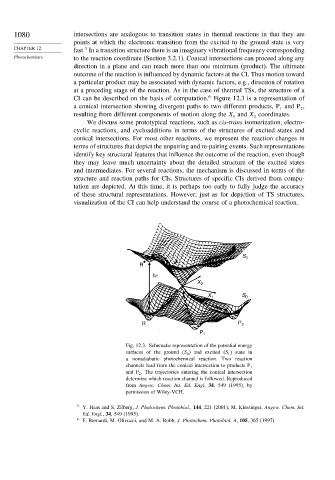Page 1095 - Advanced Organic Chemistry Part A - Structure and Mechanisms, 5th ed (2007) - Carey _ Sundberg
P. 1095
1080 intersections are analogous to transition states in thermal reactions in that they are
points at which the electronic transition from the excited to the ground state is very
5
CHAPTER 12 fast. In a transition structure there is an imaginary vibrational frequency corresponding
Photochemistry to the reaction coordinate (Section 3.2.1). Conical intersections can proceed along any
direction in a plane and can reach more than one minimum (product). The ultimate
outcome of the reaction is influenced by dynamic factors at the CI. Thus motion toward
a particular product may be associated with dynamic factors, e.g., direction of rotation
at a preceding stage of the reaction. As in the case of thermal TSs, the structure of a
6
CI can be described on the basis of computation. Figure 12.3 is a representation of
a conical intersection showing divergent paths to two different products, P and P ,
1 2
resulting from different components of motion along the X and X coordinates.
1
2
We discuss some prototypical reactions, such as cis-trans isomerization, electro-
cyclic reactions, and cycloadditions in terms of the structures of excited states and
conical intersections. For most other reactions, we represent the reaction changes in
terms of structures that depict the unpairing and re-pairing events. Such representations
identify key structural features that influence the outcome of the reaction, even though
they may leave much uncertainty about the detailed structure of the excited states
and intermediates. For several reactions, the mechanism is discussed in terms of the
structure and reaction paths for CIs. Structures of specific CIs derived from compu-
tation are depicted. At this time, it is perhaps too early to fully judge the accuracy
of these structural representations. However, just as for depiction of TS structures,
visualization of the CI can help understand the course of a photochemical reaction.
S 1
R
hν
X 2
X 1 S 0
R P 2
P 1
Fig. 12.3. Schematic representation of the potential energy
surfaces of the ground (S 0 ) and excited (S 1 ) state in
a nonadiabatic photochemical reaction. Two reaction
channels lead from the conical intersection to products P 1
and P 2 . The trajectories entering the conical intersection
determine which reaction channel is followed. Reproduced
from Angew. Chem. Int. Ed. Engl, 34, 549 (1995), by
permission of Wiley-VCH.
5 Y. Haas and S. Zilberg, J. Photochem. Photobiol., 144, 221 (2001); M. Klessinger, Angew. Chem. Int.
Ed. Engl., 34, 549 (1995).
6
F. Bernardi, M. Olivucci, and M. A. Robb, J. Photochem. Photobiol. A, 105, 365 (1997).

